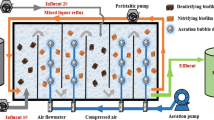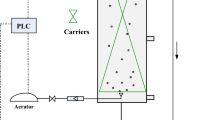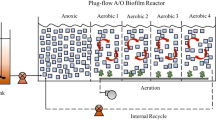Abstract
The relative locations of AOB, NOB, and DNB were examined for three different kinds of carriers in two types of hybrid biofilm process configurations: integrated fixed-film activated sludge (IFAS) and moving bed biofilm reactor (MBBR) processes. IFAS water resource recovery facilities (WRRFs) used Anodkalness K1 carriers (KC) at Broomfield, Colorado, USA and polypropylene resin carriers (RC) at Fukuoka, Japan, while MBBR WRRFs used KC carriers at South Adams County, Colorado, UsA and sponge carriers (SC) at Saga, Japan. Influent COD to N ratios ranged from 8:1 to 15:1. The COD and BOD removal efficiencies were high (96%–98%); NH4+-N and TN removal efficiencies were more varied at 72%–98% and 64%–77%, respectively. The extent of TN removal was higher at high SRT, high COD:N ratio and low DO concentration in the anoxic tank. In IFAS, RC with high specific surface area (SSA) maintained higher AOB population than KC. Sponge carriers with high SSA maintained higher overall bacteria population than KC in MBBR systems. However, the DNB were not more abundant in high SSA carriers. The diversity of AOB, NOB, and DNB was fairly similar in different carriers. Nitrosomonas sp. dominated over Nitrosospira sp. while denitrifying bacteria included Rhodobacter sp., Sulfuritalea sp., Rubrivivax sp., Paracoccus sp., and Pseudomonas sp. The results from this work suggest that high SRT, high COD:N ratio, low DO concentration in anoxic tanks, and carriers with greater surface area may be recommended for high COD, BOD and TN removal in WRRFs with IFAS and MBBR systems.

Similar content being viewed by others
References
APHA (2005). Standard Methods for the Examination of Water and Wastewater. Washington DC: American Public Health Association
Bassin J P, Kleerebezem R, Rosado A S, van Loosdrecht M C M, Dezotti M (2012). Effect of different operational conditions on biofilm development, nitrification, and nitrifying microbial population in moving-bed biofilm reactors. Environmental Science & Technology, 46(3): 1546–1555
Boltz J P, Johnson B R, Daigger G T, Sandino J (2009). Modeling integrated fixed-film activated sludge and moving-bed biofilm reactor systems I: Mathematical treatment and model development. Water Environment Research, 81(6): 555–575
Choi J, Hwang G, Gamal El-Din M, Liu Y (2014). Effect of reactor configuration and microbial characteristics on biofilm reactors for oil sands process-affected water treatment. International Biodeterioration & Biodegradation, 89: 74–81
Chu L, Wang J (2011). Comparison of polyurethane foam and biodegradable polymer as carriers in moving bed biofilm reactor for treating wastewater with a low C/N ratio. Chemosphere, 83(1): 63–68
Cydzik-Kwiatkowska A (2015). Bacterial structure ofaerobic granules is determined by aeration mode and nitrogen load in the reactor cycle. Bioresource Technology, 181: 312–320
Daniel L M C, Pozzi E, Foresti E, Chinalia F A (2009). Removal of ammonium via simultaneous nitrification-denitrification nitrite-short cut in a single packed-bed batch reactor. Bioresource Technology, 100(3): 1100–1107
de Kreuk M, Heijnen J J, van Loosdrecht M C M (2005). Simultaneous COD, nitrogen, and phosphate removal by aerobic granular sludge. Biotechnology and Bioengineering, 90(6): 761–769
Feng Q, Cao J S, Chen L N, Guo C Y, Tan J Y, Xu H L (2011). Simultaneous nitrification and denitrification at variable C/N ratio in aerobic granular sequencing batch reactors. Journal of Food Agriculture and Environment, 9(3–4): 1135–1140
Guo J, Peng Y, Wang S, Zheng Y, Huang H, Wang Z (2009). Long-term effect of dissolved oxygen on partial nitrification performance and microbial community structure. Bioresource Technology, 100(11): 2796–2802
Hoang V, Delatolla R, Abujamel T, Mottawea W, Gadbois A, Laflamme E, Stintzi A (2014). Nitrifying moving bed biofilm reactor (MBBR) biofilm and biomass response to long term exposure to 1°C. Water Research, 49: 215–224
Holt J G, Krieg N R, Sneath P H A, Staley J T, Williams S T (1994). Bergey’s Manual of Determentative Bacteriology. Baltimore: Williams and Wilkins
Huang C, Shi Y, Xue J, Zhang Y, Gamal El-Din M, Liu Y (2017). Comparison of biomass from integrated fixed-film activated sludge (IFAS), moving bed biofilm reactor (MBBR) and membrane bioreactor (MBR) treating recalcitrant organics: Importance of attached biomass. Journal of Hazardous Materials, 326: 120–129
Javid A H, Hassani A H, Ghanbari B, Yaghmaeian K (2013). Feasibility of utilizing moving bed biofilm reactor to upgrade and retrofit municipal wastewater treatment plants. International Journal of Environmental of Research, 7(4): 963–972
Johnson T L, Shaw A, Phillips H, Choi N, Lauro T, Butler R, Radko L (2007). A pilot-scale comparison of IFAS and MBBR to achieve very low total nitrogen concentrations. Water Practice and Technology, 1(5): 1–14
Kamei T, Eamrat R, Shinoda K, Tanaka Y, Kazama F (2019). Coupled anaerobic ammonium oxidation and hydrogenotrophic denitrification for simultaneous NH4-N and NO3-N removal. Water Science and Technology, 79(5): 975–984
Kim H S, Schuler A J, Gunsch C K, Pei R, Gellner J, Boltz J P, Freudenberg R G, Dodson R (2011). Comparison of conventional and integrated fixed-film activated sludge systems: attached-and suspended-growth functions and quantitative polymerase chain reaction measurements. Water Environment Research, 83(7): 627–635
Kim Y M, Park H, Cho K H, Park J M (2013). Long term assessment of factors affecting nitrifying bacteria communities and N-removal in a full-scale biological process treating high strength hazardous waste-water. Bioresource Technology, 134: 180–189
Li C, Li X L, Ji M, Liu J (2012). Performance and microbial characteristics of integrated fixed-film activated sludge system treating industrial wastewater. Water Science and Technology, 66(12): 2785–2792
Magnusson G, Edin H, Dalhammar G (1998). Characterisation of efficient denitrifying bacteria strains isolated from activated sludge by 16S-rDNA analysis. Water Science and Technology, 38(8–9): 63–68
McCaig A E, Glover A, Prosser J I (2001). Numerical analysis of grassland bacterial community structure under different land management regimens by using 16S ribosomal DNA sequence data and denaturing gradient gel electrophoresis banding patterns. Applied and Environmental Microbiology, 67(10): 4554–4559
Metcalf and Eddy (2004). Wastewater Engineering: Treatment and Reuse. New York: McGraw-Hill
Miksch K, Sikora J (2010). Biotechnologia scieków (Wastewater biotechnology). Warszawa: Polish Scientific Publishers PWN (In polish)
Muyzer G, de Waal E C, Uitterlinden A G (1993). Profiling of complex microbial populations by denaturing gradient gel electrophoresis analysis of polymerase chain reaction amplified genes coding for 16S rRNA. Applied and Environmental Microbiology, 59(3): 695–700
Ødegaard H (2006). Innovations in wastewater treatment: the moving bed biofilm process. Water Science and Technology, 53(9): 17–33
Ødegaard H, Gisvold B, Strickland J (2000). The influence of carrier size and shape in the moving bed biofilm process. Water Science and Technology, 41(4–5): 383–391
Onnis-Hayden A, Majed N, Schramm A, Gu A Z (2011). Process optimization by decoupled control of key microbial populations: distribution of activity and abundance of polyphosphate-accumulating organisms and nitrifying populations in a full-scale IFAS-EBPR plant. Water Research, 45(13): 3845–3854
Pal L, Kraigher B, Brajer-Humar B, Levstek M, Mandic-Mulec I (2012). Total bacterial and ammonia-oxidizer community structure in moving bed biofilm reactors treating municipal wastewater and inorganic synthetic wastewater. Bioresource Technology, 110: 135–143
Reboleiro-Rivas P, Martín-Pascual J, Juárez-Jiménez B, Poyatos J M, Vílchez-Vargas R, Vlaeminck S E, Rodelas B, González-López J (2015). Nitrogen removal in a moving bed membrane bioreactor for municipal sewage treatment: Community differentiation in attached biofilm and suspended biomass. Chemical Engineering Journal, 277: 209–218
Seifi M, Fazaelipoor M H (2012). Modeling simultaneous nitrification and denitrification (SND) in a fluidized bed biofilm reactor. Applied Mathematical Modelling, 36(11): 5603–5613
Shao Y, Shi Y, Mohammed A, Liu Y (2017). Wastewater ammonia removal using an integrated fixed-film activated sludge-sequencing batch biofilm reactor (IFAS-SBR): Comparison of suspended flocs and attached biofilm. International Biodeterioration & Biodegradation, 116: 38–47
Siripong S, Rittmann B (2007). Diversity study of nitrifying bacteria in full-scale municipal wastewater treatment plants. Water Research, 41(5): 1110–1120
Tan C, Ma F, Li A, Qiu S, Li J (2013). Evaluating the effectofdissolved oxygen on simultaneous nitrification and denitrification in polyurethane foam contact oxidation reactors. Water Environment Research, 85(3): 195–202
van den Akker B, Beard H, Kaeding U, Giglio S, Short M D (2010). Exploring the relationship between viscous bulking and ammoniaoxidiser abundance in activated sludge: a comparison of conventional and IFAS systems. Water Research, 44(9): 2919–2929
Wang S, Parajuli S, Sivalingam V, Bakke R (2018). Biofilm in moving bed biofilm process for wastewater treatment. In: Dincer S, Sümengen Özdenefe M, Arkut A, editors. Bacteria Biofilms. London: IntechOpen, 88520: 1–15
Xia S, Li J, Wang R (2008). Nitrogen removal performance and microbial community structure dynamics response to carbon nitrogen ratio in a compact suspended carrier biofilm reactor. Ecological Engineering, 32(3): 256–262
Yang S F, Tay J H, Liu Y (2004). Respirometric activaties of heterotrophic and nitrifying populations in aerobic granules developed at different substrate N/COD ratios. Current Microbiology, 49(1): 42–46
Zhang L, Zhang S, Peng Y, Han X, Gan Y (2015). Nitrogen removal performance and microbial distribution in pilot- and full-scale integrated fixed-biofilm activated sludge reactors based on nitritation-anammox process. Bioresource Technology, 196: 448–453
Zhang Q, Chen X, Luo W, Wu H, Liu X, Chen W, Tang J, Zhang L (2019). Effects of temperature on the characteristics of nitrogen removal and microbial community in post solid-phase denitrification biofilter process. International Journal of Environmental Research and Public Health, 16(22): 1–15
Zhu X L, Yu J Y, Wu Z X, Yao L (2014). The preparation of iron ore tailings bio fiber filter material and domestic sewage treatment. Advanced Materials Research, 997: 877–881
Ziembińska A, Ciesielski S, Miksch K (2009). Ammonia oxidizing bacteria community in activated sludge monitored by denaturing gradient gel electrophoresis (DGGE). Journal of General and Applied Microbiology, 55(5): 373–380
Acknowledgements
This research study was financially supported by the National Research Council of Thailand (NRCT) (#105/2563), Faculty of Engineering Kasetsart University, Bangkok, Thailand (Post Doc. 62/08.ENV) and Kasetsart University Research and Development Institute (KURDI) (#ENV/2563). The authors also thank Ms. Nimaradee Boonapatcharoen and Dr. Somkiet Techkarnjanaruk at Pilot Plant Development and Training Institute, King Mongkut’s University of Technology Thonburi (Bangkuntien) for giving helpful suggestions on molecular techniques.
Author information
Authors and Affiliations
Corresponding author
Additional information
Highlights
• Two IFAS and two MBBR full-scale systems (high COD:N ratio 8:1) were characterized.
• High specific surface area carriers grew and retained slow-growing nitrifiers.
• High TN removal is related to high SRT and low DO concentration in anoxic tanks.
Supplementary Material
Rights and permissions
About this article
Cite this article
Phanwilai, S., Kangwannarakul, N., Noophan, P.(. et al. Nitrogen removal efficiencies and microbial communities in full-scale IFAS and MBBR municipal wastewater treatment plants at high COD:N ratio. Front. Environ. Sci. Eng. 14, 115 (2020). https://doi.org/10.1007/s11783-020-1374-2
Received:
Revised:
Accepted:
Published:
DOI: https://doi.org/10.1007/s11783-020-1374-2




